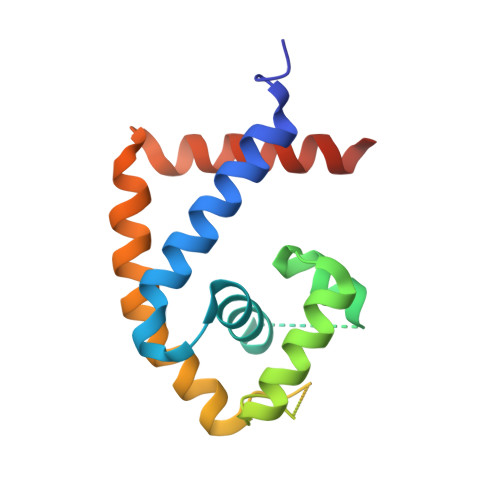The Oxidation-sensing Regulator (MosR) Is a New Redox-dependent Transcription Factor in Mycobacterium tuberculosis.
Brugarolas, P., Movahedzadeh, F., Wang, Y., Zhang, N., Bartek, I.L., Gao, Y.N., Voskuil, M.I., Franzblau, S.G., He, C.(2012) J Biol Chem 287: 37703-37712
- PubMed: 22992749
- DOI: https://doi.org/10.1074/jbc.M112.388611
- Primary Citation of Related Structures:
4FX0, 4FX4 - PubMed Abstract:
Mycobacterium tuberculosis thrives in oxidative environments such as the macrophage. To survive, the bacterium must sense and adapt to the oxidative conditions. Several antioxidant defenses including a thick cell wall, millimolar concentrations of small molecule thiols, and protective enzymes are known to help the bacterium withstand the oxidative stress. However, oxidation-sensing regulators that control these defenses have remained elusive. In this study, we report a new oxidation-sensing regulator, Rv1049 or MosR (M. tuberculosis oxidation-sensing regulator). MosR is a transcriptional repressor of the MarR family, which, similarly to Bacillus subtilis OhrR and Staphylococcus aureus MgrA, dissociates from DNA in the presence of oxidants, enabling transcription. MosR senses oxidation through a pair of cysteines near the N terminus (Cys-10 and Cys-12) that upon oxidation forms a disulfide bond. Disulfide formation rearranges a network of hydrogen bonds, which leads to a large conformational change of the protein and dissociation from DNA. MosR has been shown previously to play an important role in survival of the bacterium in the macrophage. In this study, we show that the main role of MosR is to up-regulate expression of rv1050 (a putative exported oxidoreductase that has not yet been characterized) in response to oxidants and propose that it is through this role that MosR contributes to the bacterium survival in the macrophage.
Organizational Affiliation:
Department of Chemistry and Institute for Biophysical Dynamics, The University of Chicago, Chicago, Illinois 60637, USA.














